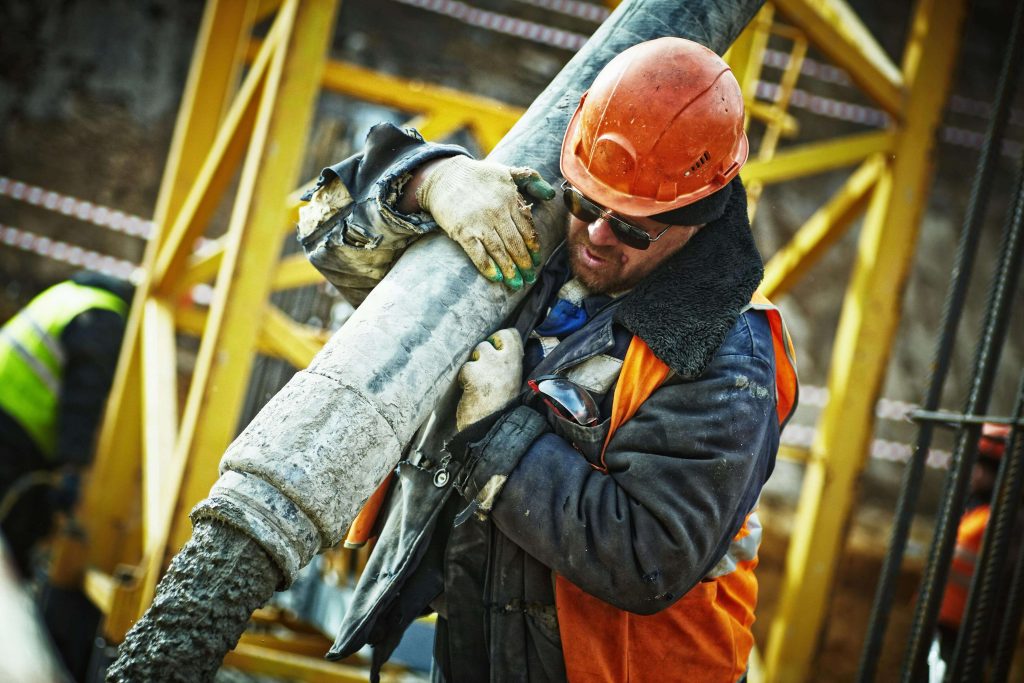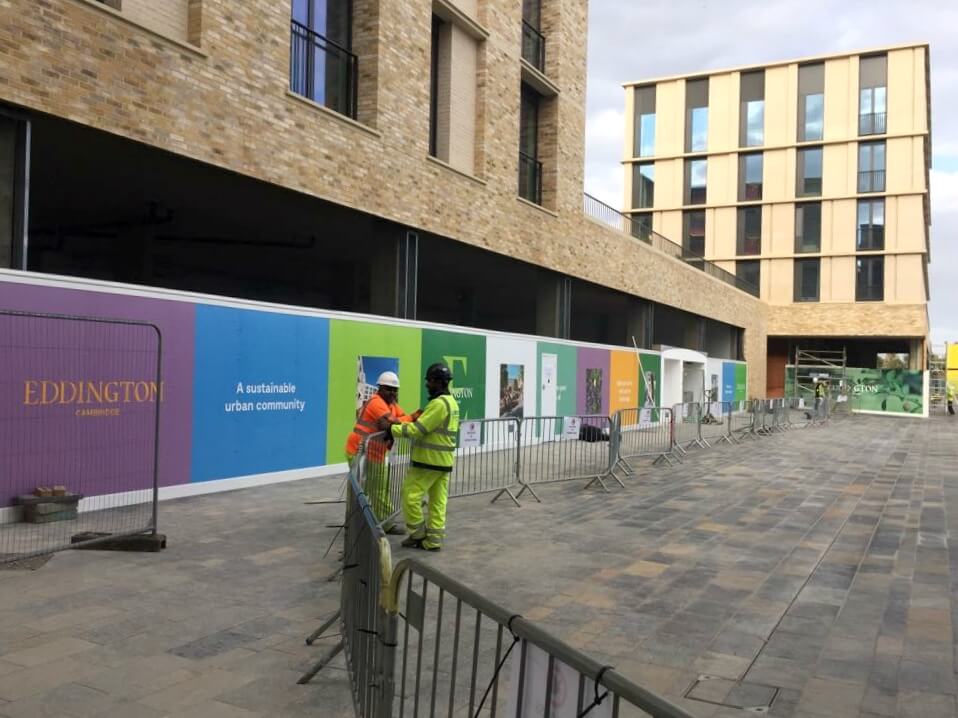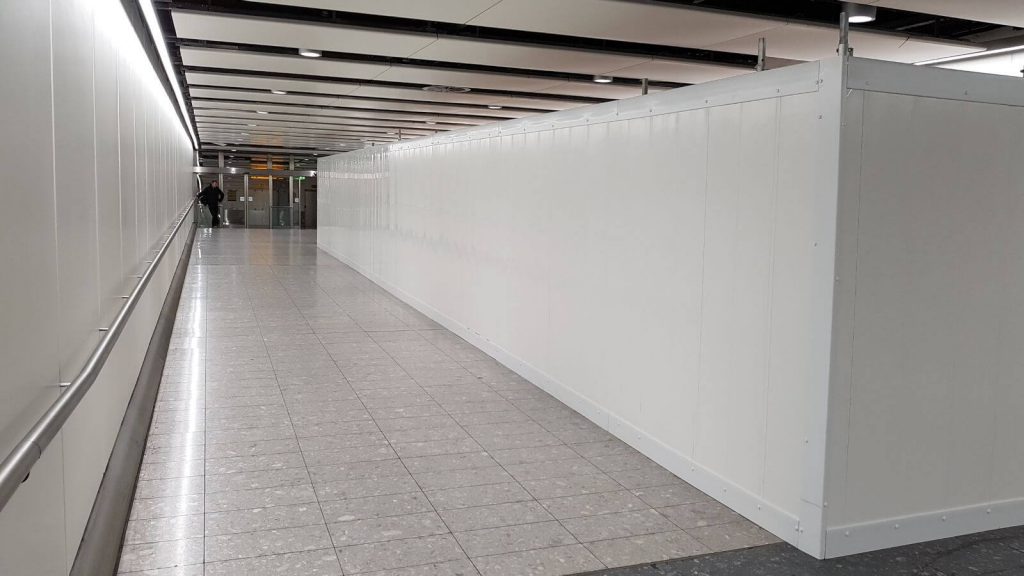Site hoarding regulations are a crucial aspect of construction project management, ensuring safety, security, and compliance with legal requirements.
This comprehensive guide will explore the various regulations and requirements surrounding site hoarding in the UK, providing construction professionals with essential information to maintain safe and legally compliant worksites.
We’ll delve into the importance of proper site hoarding, key legal obligations, best practices, and more.
By the end of this article, you’ll have a thorough understanding of site hoarding regulations and how to implement them effectively on your building sites.

The Importance of Site Hoarding
Site hoarding serves multiple purposes on construction sites, making it an indispensable element of any building project.
Here are some key reasons why site hoarding is crucial:
- Safety: Site hoarding acts as a protective barrier, or perimeter fencing, preventing unauthorised access to potentially dangerous construction areas. It helps safeguard both the public and construction workers from accidents and injuries.
- Security: By enclosing the construction site, hoarding deters theft, vandalism, and other criminal activities. It protects valuable equipment, materials, and ongoing work from potential thieves or threats, almost acting like a security guard around the perimeter of the site for the duration of construction.
- Legal Compliance: Proper site hoarding is a legal requirement in the UK, and failure to comply with regulations can result in hefty fines and potential project delays.
- Branding and Marketing: Many construction companies use site hoarding as an opportunity to showcase their brand and promote the project, turning it into a valuable marketing tool.
- Noise and Dust Control: Well-designed hoarding can help reduce noise pollution and contain dust, minimising the impact of construction activities on surrounding areas.

Key Legal Requirements for Site Hoarding Construction Site Hoarding Regulations
When it comes to site hoarding, there are several legal requirements that construction companies must adhere to.
These regulations are primarily governed by the Construction (Design and Management) Regulations 2015 (CDM 2015) and local authority guidelines.
Here are the key legal obligations:
-
Planning Permission
Obtaining Necessary Approvals
Before erecting site hoarding, it’s essential to check whether planning permission is required. While temporary structures like site hoardings often fall under permitted development rights, there are exceptions:
- Height restrictions: Hoardings exceeding 2 metres in height typically require planning permission.
- Conservation areas: Special rules may apply in conservation areas or for listed buildings.
- Advertising: If the hoarding will display advertisements, additional consent may be needed. To ensure compliance, consult with your local planning authority before installation.
-
Health and Safety Requirements
The CDM 2015 regulations place a strong emphasis on site safety, including requirements for site hoarding:
- Stability: Hoarding must be sufficiently stable to withstand wind loads and other environmental factors.
- Maintenance: Regular inspections and maintenance are necessary to ensure the hoarding remains safe and secure throughout the project.
- Access control: Proper gates and access points must be incorporated to control entry and exit from the site.

-
Visibility and Lighting
Adequate visibility is crucial for site safety, especially during low-light conditions:
- Reflective materials: Use reflective strips or paint on hoarding to improve visibility at night.
- Lighting: Ensure proper lighting around the site perimeter, particularly at access points and pedestrian walkways.
- Warning signs: Display clear warning signs and contact information for emergencies.
-
Pedestrian and Traffic Management
Safeguarding Public Access and Movement
Construction sites must not impede public rights of way or create hazards for pedestrians and vehicles:
- Footpath diversions: If hoarding obstructs a public footpath, provide clear alternative routes with appropriate signage.
- Traffic management: Implement necessary traffic control measures if the hoarding affects road users.
- Accessibility: Ensure that the hoarding design accommodates people with disabilities, including those using wheelchairs or with visual impairments.
-
Environmental Considerations
Site hoarding should also address environmental concerns:
- Noise reduction: Use acoustic hoarding materials in noise-sensitive areas.
- Dust control: Implement dust suppression measures, such as debris netting or solid panels.
- Waste management: Properly dispose of hoarding materials at the end of the project, adhering to waste management regulations.
Best Practices for Site Hoarding Implementation
To ensure that your site hoarding meets all regulatory requirements and serves its purpose effectively, consider the following best practices:
-
Risk Assessment
Conduct a thorough risk assessment before designing and installing site hoarding. Identify potential hazards and implement appropriate mitigation measures.

-
Professional Installation
Employ experienced professionals to design and install site hoarding. This ensures that the structure meets all safety and stability requirements.
-
Regular Inspections
Implement a schedule of regular inspections to identify and address any issues promptly. Document these inspections for compliance purposes.
-
Clear Signage
Use clear, concise signage to communicate important information, such as site rules, emergency procedures, and contact details.
-
Branding Opportunities
Utilise the hoarding as a marketing tool by incorporating high-quality graphics and project information, especially useful if you’d like to give your company’s logo or call to action some serious airtime – especially effective in city centres.
Ensure that any advertising complies with local regulations.

-
Community Engagement
Consider involving the local community in the design of site hoarding, particularly for long-term projects. This can help foster positive relationships and reduce complaints.
Conclusion
Site hoarding regulations and requirements play a vital role in ensuring the safety, security, and legal compliance of construction projects.
By adhering to these guidelines and implementing best practices, construction companies can create a safer working environment, protect the public, and maintain positive relationships with local communities.
Remember to always consult with local authorities and conduct thorough risk assessments when planning and installing site hoarding.

About Plas-Shop
At Plas-Shop, we’re a leading supplier of temporary hoarding solutions, offering a range of products designed to create safe and secure workspaces during construction or refurbishment projects.
Our hoardings are sustainable, eco-friendly, versatile and can be used in various settings, including construction sites, shopping centres, and office spaces. They’re known for their durability and customisation flexibility, whilst providing a clean, professional appearance, shielding members of the public from potential hazards.
To make the process as convenient as possible, we offer bundles with our hoardings, including everything from baseplates to screws.
We’ve been trusted by some of the most significant brands in the country, including Giorgio Armani, the BBC, BT, Dyson, and John Lewis, and are proud to serve the entire of the UK.
To get in touch, all you have to do is dial 01626 241124, or email [email protected].










